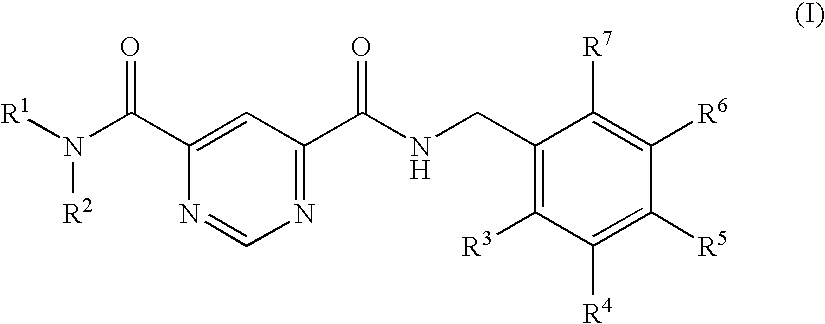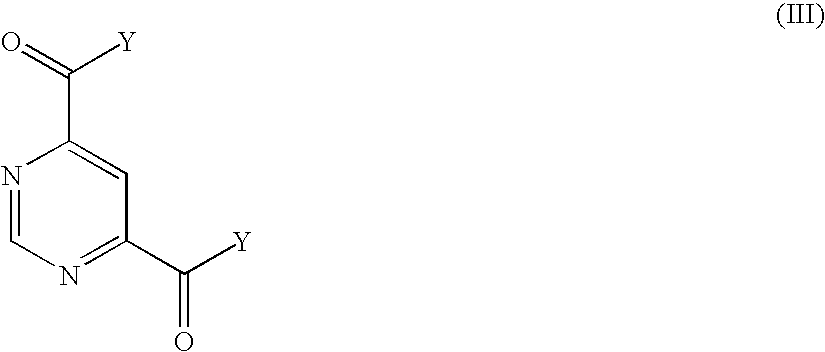Selective MMP-13 inhibitors
a selective, mmp-13 technology, applied in the field of pyrimidine4, 6dicarboxylic acid diamide compound, can solve the problems of inability to inhibit only one class of mmps, inability to bind to collagen matrix,
- Summary
- Abstract
- Description
- Claims
- Application Information
AI Technical Summary
Benefits of technology
Problems solved by technology
Method used
Image
Examples
embodiments
Another embodiment of the invention relates to the compound of formula I wherein R2 is —(C1-C4)-alkyl, where alkyl is substituted, once, twice or three times, by —C(O)—O—R8, —(C1-C4)-alkyl-O—R8, phenyl that is substituted, once, twice or three times, independently of each other, by R11, or Het that is azepine, azetidine, aziridine, benzimidazole, benzo[1,4]dioxin, 1,3-benzodioxole, benzofuran, 4H-benzo[1,4]oxazine, benzoxazole, benzothiazole, benzothiophene, quinazoline, quinoline, quinoxaline, chroman, cinnoline, oxirane, 1,2-diazepine, 1,3-diazepine, 1,4-diazepine, 1,4-dioxin, dioxole, furan, imidazole, indazole, indole, isoquinoline, isochroman, isoindole, isoxazole, isothiazole, 1,2-oxazine, 1,3-oxazine, 1,4-oxazine, oxazole, phthalazine, piperidine, pyran, pyrazine, pyrazole, pyridazine, pyridine, pyrimidine, pyridoimidazole, pyridopyridine, pyridopyrimidine, pyrrol, tetrazole, 1,2-thiazine, 1,3-thiazine, 1,4-thiazine, thiazole, thiophene, thiopyran, 1,2,3-triazine, 1,2,4-t...
example 1
tert-Butyl [4-({[6-(4-fluoro-3-methylbenzylcarbamoyl)pyrimidine-4-carbonyl]amino}methyl)phenoxy]acetate
tert-Butyl (4-formylphenoxy)acetate: 10 g (0.0819 mol) of 4-hydroxybenzaldehyde and 15.97 g (0.0819 mol) of tert-butyl bromoacetate were dissolved in 200 ml of 2-butanone, after which 11.32 g (0.0819 mol) of potassium carbonate were added and the mixture was heated under reflux for 2 hours (h). The mixture was then concentrated under reduced pressure and the residue was taken up in water and the solution was extracted three times with dichloromethane. The organic phase was dried (MgSO4), filtered and concentrated under reduced pressure.
Yield: 18.72 g (97%)
tert-Butyl [4-(hydroxyiminomethyl)phenoxy]acetate: 18.72 g (0.0792 mol) of tert-butyl (4-formylphenoxy)acetate were dissolved in 200 ml of water / ethanol (1:1), after which 6.056 g (0.0872 mol) of hydroxyammonium chloride and 3.169 g (0.0792 mol) of sodium hydroxide were added and the mixture was stirred under reflux for 2.5 ...
example 2
[4-({[6-(4-Fluoro-3-methylbenzylcarbamoyl)pyrimidine-4-carbonyl]-amino}methyl)phenoxy]acetic acid
83.6 mg (0.16 mmol) of tert-butyl [4-({[6-(4-fluoro-3-methylbenzylcarbamoyl-moyl)pyrimidine-4-carbonyl]amino}methyl)phenoxy]acetate (Example 31) were stirred at RT for 4 hours in 90% trifluoroacetic acid. Acetonitrile / water was then added and the precipitate was filtered off and dried.
Yield: 55 mg (76%) MS (ES+): m / e=452.15
The following compounds were prepared by a method analogous to that of Example 1.
TABLE 1ExampleStructureMS (ESI+)1508.212452.153477.004396.135463.026382.117384.118433.059411.1110407.1611473.0512448.0013380.1514399.0915404.0516382.1417443.0418448.0019418.0720429.1021382.1122377.1523404.0524477.0025449.0326368.1327443.0428418.0729473.0530377.1531366.1332382.1633409.1534446.0535398.1236396.0037418.0738396.1339379.1440449.0041394.1642394.0843405.0544383.0045365.1346393.1647388.1548380.0749392.1650399.0951434.1652391.1653358.1354380.0755360.1256394.0857392.1658391.1...
PUM
| Property | Measurement | Unit |
|---|---|---|
| structure | aaaaa | aaaaa |
Abstract
Description
Claims
Application Information
 Login to View More
Login to View More - R&D
- Intellectual Property
- Life Sciences
- Materials
- Tech Scout
- Unparalleled Data Quality
- Higher Quality Content
- 60% Fewer Hallucinations
Browse by: Latest US Patents, China's latest patents, Technical Efficacy Thesaurus, Application Domain, Technology Topic, Popular Technical Reports.
© 2025 PatSnap. All rights reserved.Legal|Privacy policy|Modern Slavery Act Transparency Statement|Sitemap|About US| Contact US: help@patsnap.com



